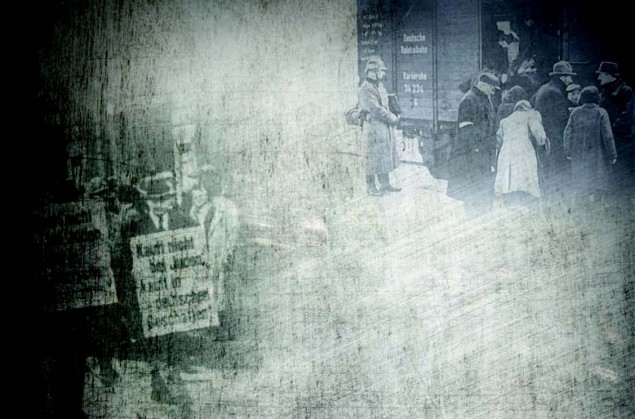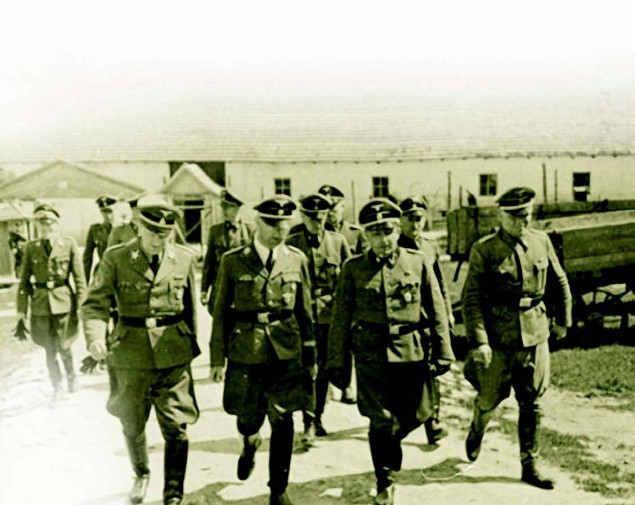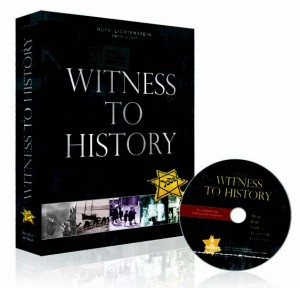
Bottom left: Jewish businessmen forced to parade down a street in Leipzig carrying signs that read, “Don’t buy from Jews. Shop at German stores!” Photo from United States Holocaust Memorial Museum (USHMM), which appears in Witness to History (p.34). Top right: A member of the German SS supervises Jews boarding trains during a deportation action in the Krakow Ghetto, 1941-1942. Photo from USHMM, which appears in Witness to History (p.146).
In the years following the Holocaust, survivors were, for the most part, silent about the devastation of European Jewry. Slowly, over time, a trickle of Holocaust memoirs and historical accounts appeared. Most of these works, however, emphasized physical heroism, such as the Warsaw Ghetto Uprising. But there was no comprehensive country-by-country treatment of the Holocaust that focused on the spiritual heroism exhibited by thousands of victims and survivors. Ruth Lichtenstein, a daughter of survivors and the publisher of the English-language edition of the Hamodia daily newspaper and the weekly Binah Magazine, has stepped in to fill this lacuna.
Lichtenstein is a granddaughter of the Gerrer Rebbe, Rabbi Avraham Mordechai Alter, known as the Imrei Emes, and of Rabbi Itche Meir Levin, the leader of Agudath Israel in prewar Europe and later in Eretz Yisrael, and the daughter of Rabbi Yehudah Aryeh Leib Levin, z”l, founding editor of the Hebrew-language Hamodia. Born in Jerusalem and currently living in New York, Lichtenstein published Witness to History, an extraordinarily impressive work that is part of her larger undertaking called Project Witness, a comprehensive nonprofit Holocaust resource center that offers academically grounded and religiously sensitive Holocaust educational resources for communities worldwide. Through Project Witness, Lichtenstein hopes to radically change the way the Holocaust is taught in day schools and yeshivot across the country. Witness to History is currently going to print for the third time.

A view of the death march from Dachau passing through German villages, secretly photographed by a German civilian. Few civilians gave aid to the prisoners on the death marches. Germany, April 29, 1945. Photo from USHMM, which appears in Witness to History (p. 520).
JA: What motivated you to undertake the publication of Witness to History?
RL: I was very attached to my father, Rabbi Yehudah Aryeh Leib Levin, a brilliant scholar, published author, and Holocaust survivor who passed away at a young age. While he accomplished so much in his short life, he had so many more plans. In addition to being a newspaper editor, he was a historian. In his writings on the Holocaust, he focused on the victims’ religious responses to the suffering as well as on the destruction of the vibrant prewar Jewish world that existed in Europe. These are the unique perspectives that historians don’t generally focus on, but my goal is to bring these perspectives to the forefront. It is my father’s work, his determination, and his legacy that has inspired me to educate future generations about the Holocaust.
JA: Can you tell us why Witness to History is groundbreaking?
RL: With its 632 pages, 1,500 pictures, and 57 maps, Witness to History is more than a history of the Holocaust. It is an epic undertaking that aims to present a country-by-country history of the Holocaust and to include the underreported wartime experiences of religious and Sephardic Jews—something no textbook has ever done. It also focuses on the Jewish spiritual resistance to the Nazis, which remains a model for all communities, teaching us how to live with compassion, faith, and dignity.
I asked one of my non-Jewish staff members to choose a few stories illustrating spiritual heroism that impressed him. He came back with four, although he said he could have picked 400. One story was about David Pishon, a Greek Jew from Saloniki. Despite the intense suffering he endured, every Friday night David was found singing many traditional Saloniki piyyutim that he remembered from home. Another example he cited was the underground Chassidic yeshivah in the Warsaw Ghetto. The teenage boys and young men in the ghetto had no food. Yet they studied Torah until the bitter end. Those are only two of the hundreds of examples.
JA: How many years of work did this project take?
RL: I thought about the project for decades, and the actual work took close to ten years.
As editor-in-chief, I worked to bring together a team of scholars, including Dr. Michael Berenbaum, a leading expert on the Holocaust, and Sir Martin Gilbert, a world-renowned historian, to serve as the project’s advisors. We were under the constant guidance of renowned rabbis as well. Rochel Licht, a researcher and teacher who worked with historian Yaffa Eliach, worked intensively on the book. Matty Lichtenstein, a gifted scholar, supervised a team of writers, editors, and a design team. This was a huge undertaking, but we were a very productive team because we all believed in the importance of this project.
JA: Sixty-six years have passed since the end of World War II. Why is it so important to teach about the Holocaust now? Why is so much of your life devoted to it?
RL: On the one hand, there are fewer and fewer survivors among us. On the other hand, Holocaust denial has become an industry. So how do we remember? Every one of us has an obligation, a chiyuv: “Zachor es asher asah lecha Amalek.” The Slonimer Rebbe, Rabbi Shalom Noach Berezovsky, z”l, emphasized the word lecha. “Remember what Amalek did lecha—to you.” That is, in your generation. He said that Amalek represents the epitome of evil that is manifested in every generation. The Nazis were the Amalek of that generation, and, as such, it is our obligation to remember the evil that they perpetrated.
JA: You have said that as a child of survivors, you read voraciously about the Holocaust for decades; you made a point to speak with survivors, and to write about the Holocaust in the newspapers. Did you ever feel you had reached a point of saturation?
RL: About eighteen years ago, I told myself, It’s enough. At that time I thought I had read enough books about the Holocaust, seen enough pictures. Then something happened that taught me that I cannot stop my work.
I came across an album titled And I Still See Their Faces, published by the Shalom Foundation in Warsaw. It contained photographs of Jewish men, women, and children in Poland that had been collected by Polish non-Jews who happened to find them. Leafing through the album, I came across a photo of someone who looked like a rav. I know this man, but from where do I know him? I thought. He looks very familiar. But I cannot remember his name. The caption read: “This picture was found wrapped in rags near the liquidated Warsaw Ghetto. The Jews’ clothes were used as cleaning rags in a German weapons factory.” I sent the picture to the Hebrew-language Hamodia (the English-language Hamodia did not exist yet), asking readers to help me identify the rav.
It took exactly twenty-four hours to get a reply. In fact, I got a very angry phone call from my cousin. “Aren’t you embarrassed?” he asked. “How could you not recognize your own great-grandfather?” It turned out that the rabbi in the photo was Harav Chanoch Tzvi HaKohen Levin, who was the rav of Bendin (Bedzin), a city in southwest Poland. He was the son-in-law of the Sefas Emes, the brother-in-law of the Imrei Emes, and the father of Rabbi Yitzchok (Itche) Meir Levin, zichronam livrachah. I learned my lesson: if I could not recognize my own great-grandparents, I still had much to learn.
JA: Is it more important to study about prewar Jewish life or about the Holocaust?
RL: We must teach the younger generation about life, not only about death. We must describe the creativity, the learning, the endless varieties of schools and synagogues, the youth groups, clubs, music, scholarship, family life, and piety that existed in prewar Europe. We also have to teach about the challenges; not everything was rosy, not everyone was religious.
How do we convey the vitality of Jewish life that existed? Even from one picture you can learn about the bubbling diversity. For example, a photo from the album I mentioned earlier is probably familiar to many of your readers. It is a photo of the inauguration of the Yeshivah Chochmei Lublin. Rabbi Meir Shapiro is seen standing with a small sefer Torah. But the caption, written by a non-Jew sheds new light on the event. It indicates that also pictured is a demonstration by the anti-religious against the new yeshivah. Additionally, the caption states that a Polish princess sent thousands of plants in order to beautify the yeshivah. This is one example of how we can mine photographs to learn history.
A caption under another photo in the album states: “We live near the train station where the trains to the death camps passed. My parents helped the Jews escape by hiding them in our home. One of the Jews left a photo behind. It has been hanging in my room for fifty years. It fell off the wall and the glass frame broke. I am an old Polish woman; I realize that when I cross the barrier of life, this picture will wind up in the trash.”
Needless to say, if that is what an old Polish woman feels about the loss of Jewish photographs, how should we feel?

SS leader Heinrich Himmlertours the Janowska concentration camp, circa August, 1942. Photo from USHMM, which appears in Witness to History (p.141).
JA: In the introduction to Witness to History, you quote this passage from your father’s book Megillat Polin (1960):
They are gone, millions of our brothers, without leaving even their memories behind. They disappeared without even stone markers to designate their graves. They are gone, and their bones did not merit a Jewish burial, disappearing instead into the furnaces of Auschwitz and Treblinka, Sobibor, and Belzec, their bodies burnt and their ashes scattered to the wind. They were not permitted fresh air during their lives, and in their deaths, were forbidden even a tiny plot of land in which to be buried. Even the most wretched human being deserves to be buried. Millions of tortured martyrs, those pure and good individuals, were not buried, and their mass graves have been turned into grazing pastures and areas of new construction. We cannot correct these wrongs, but we can and must recount the stories of these Jews to those who will come after us, so that their memories do not disappear into the abyss of
the forgotten.
Why do you feel so strongly about this quote?
RL: So many years have passed, and so little has changed. In 1960, my father finished one volume of his monumental work on 1,000 years of Polish Jewry. The volume, dedicated to the Holocaust, was published during the very early years of Holocaust study. His work preceded the Eichmann trial, which in 1961 marked the beginning of a change—it forced the Shoah into the public arena. The Holocaust was no longer a taboo subject. Some of the witnesses described incredible feats of spiritual heroism, as in the testimony of Yosef Kleiman, for example, about his friend who suffered a beating in order to sneak a prayer book into an Auschwitz barrack. People started to pay attention to survivors’ accounts, whereas before people would vilify survivors for being passive [and allowing the Holocaust to happen].
JA: Another powerful quote in your book is by Zalman Gradowski, scribbled on one of the many notes he and his friends buried in the Auschwitz grounds before his death. [Gradowski, a member of the Sonderkommando, was killed in the Sonderkommando Revolt in Auschwitz in October 1944.]
He wrote:
With the rising of tomorrow’s sun who knows if we will be able to testify to this cruel, dark night? Your heart will tell you that the cannon’s decree sealed the shattered landscape that surrounds you. Surely, you will reason, this destruction was the collateral damage of the war. You will think that the decisive elimination of the European Jewish nation came about by way of a natural disaster, as if divine hints had sufficed to open the earth beneath all the gathered Jews. You will refuse to believe this destruction quaked from the hands of men transformed into carnivorous beasts (Ber Mark, Megilat Auschwitz [Tel Aviv, 1978]).
Why is this so meaningful?
RL: There was a burning desire among many victims to leave testimonies describing what happened to them. This is most tragically expressed by the writings left by the Sonderkommando, the Jewish slave laborers sentenced to moving bodies out of the gas chambers into the crematoria. Some were Greek Jews who suffered a tragic fate. They were thrown into this hell, where, because they did not speak Yiddish, they were not even able to converse with their Jewish brethren. The Sonderkommando were assigned the most grisly jobs. Few went through such a horrible experience as they. Some of these men wrote of murders, of the number of Jews killed, of their pain and terror. They wrote on scraps of paper, pushed into bottles they sealed with wax and buried in the ground. They left these bottles because they wanted the world to know of Auschwitz; they wanted their testimony to survive even if their people perished. They were afraid, truly afraid, that no Jew would live to tell the world what they had experienced. They also felt they had to apologize for being assigned the most abhorrent tasks. They knew the Germans would kill them because they did not want the world to know what they were doing. They were trying desperately to leave a description of the gehenom they went through. We have an absolute obligation to share this with younger generations. We must be the voice of these victims.
JA: What has kept you going all these years?
RL: I view educating the public about the Holocaust as a life mission; I feel very strongly that if we, children of survivors, are not going to do something for the next generation regarding the Holocaust, our children are going to regard the Holocaust as we regard events in the history books. Unfortunately, some members of the younger generation already view the Holocaust like that.
I frequently repeat the story about a man who came to my office to share with me the experience of his ninety-four-year-old father who survived Auschwitz. His father used to go to daven daily in shul; going to shul gave him the strength to get through the day. One day he realized a young man was staring at him. The young man turned to him and said, “Reb Yid, you most probably didn’t realize your arm is dirty. There is a number on your arm. You cannot put tefillin on because this is a barrier, a chatzitzah.” The old man fainted, and when they brought him back to consciousness, he couldn’t stop crying, and kept asking rhetorically in Yiddish, “I lived to be so old, just to hear this?”
So I say let’s not build a chatzitzah between us and the six million kedoshim. One day we will have to give an accounting, a din v’cheshbon, explaining what we did in order to fulfill the mitzvah of zachor. At that time, we better have a good answer.
Bracha Mantaka is a freelance writer living in Bnei Brak. Her sister, Shira Leibowitz Schmidt, recently co-translated Rabbi Israel Meir Lau’s autobiography. The book, Out of the Depths: The Story of a Child of Buchenwald Who Returned Home At Last, will be published by OU Press.
